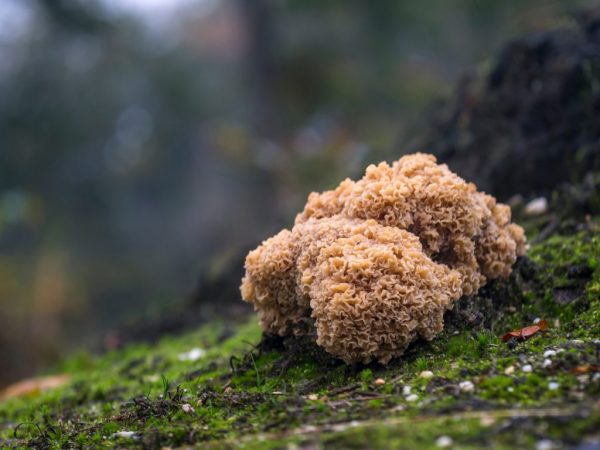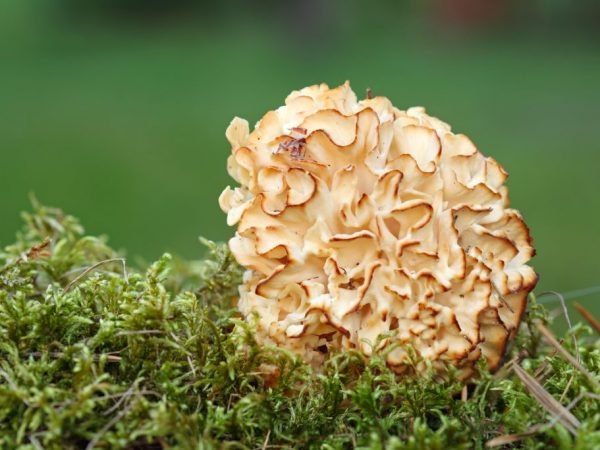Characteristics of the fungus curly sparassis
Curly sparassis is a parasitic fungus. Causes the processes of decay and decomposition in wood. It looks somewhat like a cauliflower, so it has many other names associated with this plant: hare, mushroom or upland cabbage.

Characteristics of the fungus Sparassis curly
Description of the mushroom
Curly sparassis settles on conifers. The population size has recently decreased significantly due to the deforestation of old-growth coniferous forests. In addition, people have put their efforts to the extinction of this type of fungus. Now it is listed in the Red Book of Russia, Belarus, Ukraine.
The fungus is rarely found in our forests, especially the larger specimens. It appears from the second half of the summer season, you can meet it until mid-autumn. The above-ground body can gain in diameter from 10 cm to 60 cm. Sometimes fruit bodies weighing 6-10 kg are found.
According to the species description, curly sparassis has a rounded elongated shape, it looks like a branched coral or a branched tree. Consists of flat twigs-plates. They have a wavy scalloped edge. Young mushrooms are white, creamy. It gets darker with age.
Irina Selyutina (Biologist):
Young sparassis is really whitish, but with age it is not just yellowish, but acquires an ocher color or turns brown. Moreover, the darkening begins from the edges of the blades of the fruiting body. The pulp is white and dense, has a smell that is not like mushroom and a taste reminiscent of a nut. Young mushrooms have brittle flesh, but over time it becomes woody.
The central leg reaches a length of 13 cm, but almost all of it is hidden underground. This is due to the fact that curly sparassis is a parasitic species that settles on the roots or at the base of the trunk of a coniferous tree, causing the development of red-brown destructive (destroying) rot of the roots and base of the trunk. Sometimes he can settle on fresh stumps.
While the mushroom is young, its wide, up to 5 cm leg, from which all the blades grow, has a shade variation in the border from white to pale yellow. But as it grows and, accordingly, aging, it darkens and becomes brown or black.
For your information. If in a deciduous forest on an oak they met a mushroom that looks like curly sparassis - you are very lucky, because you were able to meet the closest relative of this species - lamellar sparassis.

Sparassis curly settles on conifers
The consistency of the pulp in the plates also gives away the age of the specimen. In young people, it is soft, tender, has a nutty and pleasant taste. Over time, it becomes tougher, and it can no longer be used as food.
Mushroom properties
Curly Sparassis contains a large amount of beta-glucan polysaccharide, more than 40% dry weight. This substance has a striking immunomodulatory property and is widely used in pharmacology in all countries of the world. It is a strong antioxidant, counteracts the development of tumor, inflammatory and allergic processes.
Sparassis curly contains sparassol - a compound that prevents the development of molds, protects against pests and various diseases. It also benefits people, as it has antimicrobial and antimycotic activity.
The components of curly sparassis have the following medicinal properties:
- antineoplastic;
- antioxidant;
- immunomodulatory;
- antibacterial;
- antifungal.
The fungus helps allergy sufferers, hypertensive patients and people who have suffered post-stroke conditions, as well as those suffering from diabetes.
Traditional medicine is known for the effectiveness of sparassis curly in the fight against malignant tumors, especially melanoma and sarcoma. It is also used in the treatment of hormonal disorders, obesity.
By the way. In the countries of Southeast Asia, sprassis has long been widely used in pharmacology.
Contraindications
Curly sparassis, like other types of mushrooms, is undesirable to give to children under 6 years of age. They are not included in the diet of people with pathologies of the gastrointestinal tract, kidneys, and liver. It is a heavy food and puts a serious strain on the digestive organs.
Growing methods
The wild sparassis mushroom cannot be used for personal needs due to its rarity. But you can grow it yourself. When grown at home, the technology is the same as when cultivating oyster mushrooms. The only difference is that the sawdust must be taken fresh and only from coniferous trees.
Irina Selyutina (Biologist):
Indeed, the cultivation of curly sparassis on sawdust is similar to the cultivation of oyster mushrooms, however, let's highlight the main points in the cultivation of sparassis:
- Coniferous sawdust (pine, spruce, cedar, fir, larch) should not even contain traces of chemical compounds used to treat wood in the fight against parasites and pathogens.
- Sawdust is mixed with a small amount of bran, hay, gypsum, combined mineral dressing.
- Pour the prepared mixture with water and boil for 1-2 hours to destroy the competing microflora present in the substrate.
- Cool the mixture completely in water, then drain and spread the mixture on a fine mesh, allowing the water to drain. Substrate readiness indicator - sawdust should be moist to the touch, but should not stick to your hands. This will be the optimum humidity level of 70%.
- Fold the prepared substrate into polyethylene bags: in this case, each layer of the substrate 5 cm thick is poured with crushed mycelium. The bag is tightly tied.
- When the mycelium sprouts and covers the substrate, 2x2 cm holes are cut in the bags for the fruit bodies to emerge to the surface.
Fruit bodies are cut with a knife.
It is best to grow this species on a personal plot using a felled or felled tree. It is advisable to choose coniferous trunks. The wood must be fresh, illegal. They make holes in it with a drill at a distance of 10-15 cm, fill them with mycelium, seal the hole with sawdust. The log should necessarily with its entire lower surface lie on the ground so that you can draw moisture from it. The method of growing on a log is considered to be less troublesome compared to growing it on a block.
The mushroom is widely grown in Japan and Korea. Not only food products are made from it. The substances contained in the plant are widely used in the manufacture of medicines, dietary supplements.
How to cook a mushroom
It is necessary to cook the mushroom according to a certain algorithm, which is offered by those who have already dealt with this type of mushroom several times.
- Immerse in cold water for ¼ hour. This will make it easier to clean up "forest debris" - sticky pine needles, grass.
- Rinse the fruit bodies with cold water and chop with a knife, fingers.
- Pour the cut pieces so that the liquid covers their surface, salt.
- Cook for 20 minutes. After boiling and the appearance of foam, reduce the fire, remove the noise.
- Let the boiled mass drain in a colander.
Important.Curly sparassis cannot be digested. Otherwise, it will fall apart and lose its extraordinary taste. For the same reason, you should not add spices. Boil in milk for a richer flavor.
Dryagel curly, aka curly sprassis, is suitable for all types of culinary processing, with the exception of salting and pickling. Those who eat this mushroom often enough say with confidence that it manifests itself best of all when frying, stewing with sour cream and in making soups. In addition, it is recommended to bake it with cheese, meat, seafood. It will be a great filling for savory baked goods. Dried and powdered mushrooms are also perfect for sauces and gravies.
But, it is important not to forget that since it is a tree fungus, its fruiting bodies will be edible only if they are light in color (youth). Older specimens already acquire a bitter taste and become woody. For your information. No cases of sparassis curly poisoning have been reported.
Conclusion
Curly sparassis cannot be plucked, destroyed. This species is on the verge of complete extinction and needs human care. Therefore, when meeting in the forest, it is better to try to hide it from unscrupulous mushroom pickers, curious tourists. This will give you the opportunity to make your own contribution to the conservation of nature.



